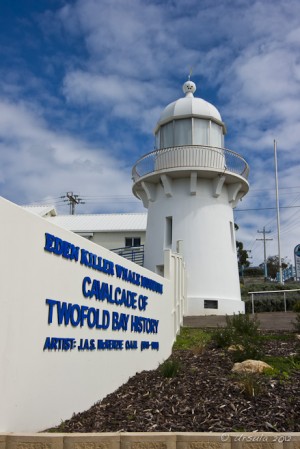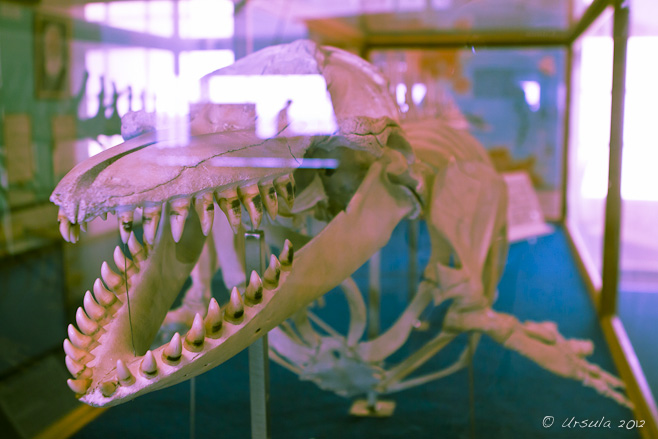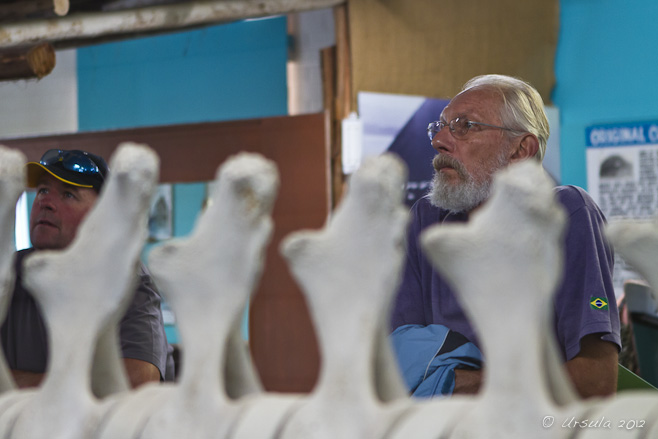
Outer wall of the Eden Killer Whale Museum
Some stories are better than fiction.
In Eden, where we now live, people have had a long relationship with the sea and the sea’s creatures – especially whales.
The earliest inhabitants of the area, the Thawa people of the Yuin nation, conducted ceremonies and feasts in honour of killer whales – orcas – whom they called Beowas; “brothers” or “kin”. Because these mammals are marked black and white like corroboree dancers, they were believed to be warrior ancestors: “reborn from the dreaming to the sea”. This belief was reinforced by the orcas’ practice of herding seals and other sea animals into shallow waters, making them accessible prey for the Thawa.
The first European whalers set up in Twofold Bay in 1828, and the town itself was established not long after. Before the development of petroleum-based products, whale oil was burned for light, or made into clean-burning tapers and candles. It was also used extensively for lubrication, tanning and soap manufacture, while the baleen was used in the making of corsets and parasols.
Of course, in those early days, whaling was a much more even-handed battle, with the shore-based whalers, armed only with harpoons, rowing open wooden boats out after the longer and much heavier right whales and humpbacks.
Some of the Eden whalers had help in their hunt of these massive prey: every year in late autumn, killer whales would swim to Twofold Bay from the waters of Antarctica and wait for the baleen whales to pass on their annual migration north to breed. When baleen whales were found, one of three separate pods of killer whales would routinely alert the men at the Davidson whaling station, assist them in herding – or even killing – the giant animals, and then take their reward of lips and tongue before leaving the rest of the carcass to the whalers. Although orcas routinely hunt in well-organized packs, this is the only place in the world where they have collaborated with man. There are numerous, well-documented stories of the symbiotic relationship between the whalers and the orcas; a relationship which started to break down in the early 1900’s.
The best known and most loved of these orcas was Old Tom, a 22-foot male who was reputed to be well over 70 when he died. (Some scientists have claimed that tooth-ring study demonstrates he was about 35, and they suggest that more than one whale was responsible for sightings of Old Tom’s distinctive dorsal fin over a period of 70+ years. Other scientists say ‘ageing’ of mature whales is an inexact science at best, and no one knows how long killers live.) When his body floated into Snug Harbour in 1930, it was decided to preserve his remains, and build a museum to house them.
This single event marked the beginning of the Eden Killer Whale Museum, and signalled the end of Eden’s whale industry.

Almost abstract: Old Tom reflecting his museum

Visitors read the story of Old Tom from behind the bones of his spine.

False killer whale (seudorca crassidens) skeleton: about half the size of a "real" killer whale.

Anyone who has visited Australia will have met the adorable sniffer beagles who work the customs' beat. Of course, with the sixth longest coastlines in the world (25,760 km according to the CIA World Factbook), Australia puts a lot of effort into marine border protection.

Lifeboats on display: Eden Killer Whale Museum

Part of a derrick crane: load limit, 5 tonnes.

The Lighthouse: Eden Killer Whale Museum.

Scrimshaw, the practice of etching a design into whalebone or tooth, was a common leisure activity for whalers in the days when ivory was a legal, plentiful commodity.

Twofold Bay from the Eden Killer Whale Museum.

Whale Vertabrae

Printout from an old depth sounder.

The Eden Killer Whale Museum derrick crane and lighthouse.

Light winds and a blue sky.

Mirror reverse: The Giftshop

Along the street, in front of the museum, a series of seven mosaics depict Eden's history, from the original residents: the Thawa people of the Yuin nation, to the present.

The Whaler and their Lighthouse: Eden Killer Whale Museum.
The orcas disappeared from Eden waters after the death of Old Tom and are a much rarer sight these days. The last Eden whaling operation closed in the late 1920s, when baleen whale numbers were already declining from operations elsewhere (The Davidson station usually netted about eight whales a year: significantly fewer than the larger commercial operations, even at that time.) Whales and dolphins have been protected in Australian waters since 1979, and every year the humpbacks pass through Eden’s sapphire blue waters in spring – with no whalers and very few orcas to harass them.
We hope to be back to catch some – with our cameras – on their next passage.
 Maybe we’ll even see descendants of Old Tom!
Maybe we’ll even see descendants of Old Tom!
Till next time.
Pictures and visit: 18 March 2012





















.jpg)


Great story Ursula!
I really do have some fond memories of that place Ursula and you have captured the place so well… we really need to come back down there now Phillip is a little older, he was only a tot when we were there last and still has the little replica boat he purchased in the shop. Thank you for sharing this and reminding me of the delightful place Eden is.
Thanks, Lisa!
Signe – the room is ready: Friends and Facbookers free from October-mid-December. Book your time now! 😉
Great story indeed Ursula and Eden sounds a wonderful place. I found the story of the Davidsons fascinating – we have sadly lost touched with nature…
Anna :o]
Ursula, dit was weer een mooi en interessant verhaal en met mooie foto’s onderlegd. Groetjes Dietmut
Ik ben blij dat je hebt genoten, Dietmut! (I hope that is correct – it’s Google-Dutch!)
Greetings, Anna! The Davidsons certainly were unusual for their time. 🙂
Great piece and looking forward to seeing them during the migration.
[…] Meeting Old Tom – Ursula’s Weekly WandersMay 31, 2012 … Pictures of Eden’s Killer Whale Museum, and the story of 100 years of cooperation between men and orcas in hunting baleen whales off … […]
The photo you have labelled as Old Tom is the false killer whale skeleton on display.
Hi Jody,
Thanks for taking the time to comment. I’ve checked my files, and other pictures on line, and I’m pretty sure that the first skeleton is Old Tom. The toothless False Killer Whale on display is two pictures down.
Cheers, Ursula